The Cost of Kiteboarding Equipment Explained
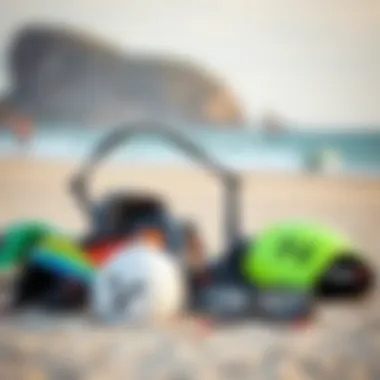
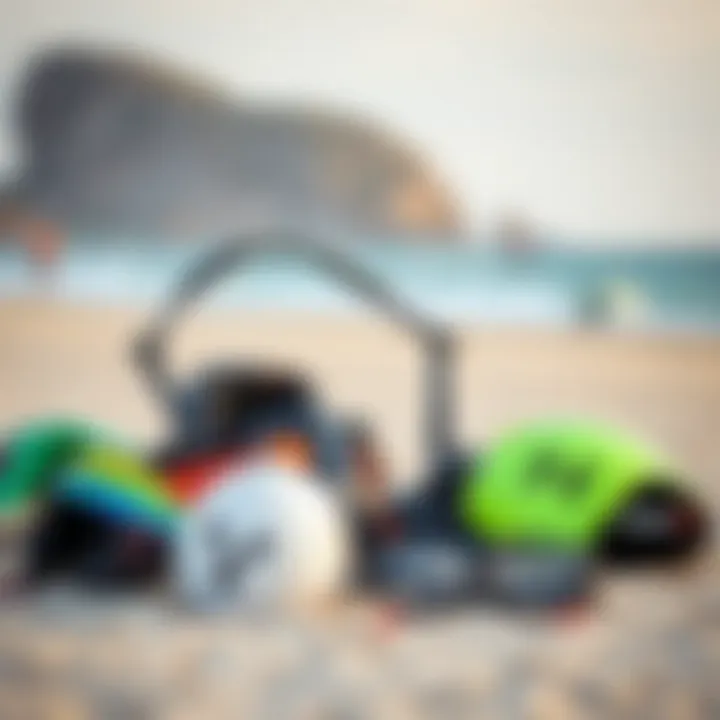
Intro
Kiteboarding, an exhilarating blend of surfing and paragliding, attracts many individuals yearning for adventure. Yet, while the thrill is surely worth the effort, the financial side can be daunting, especially for those entering the sport. Understanding the cost dynamics of kiteboarding equipment is crucial for both beginners and seasoned aficionados alike.
Grasping the underlying factors that influence prices can make all the difference. There’s more to it than mere brand names or flashy designs; elements such as material quality, technology advancements, and market trends play a pivotal role. In this article, we will dissect these considerations, enabling you to make wisely informed choices as you outfit yourself for the water.
By addressing budgeting strategies and dissecting essential gear requirements, our goal is to bring clarity to your purchasing decisions. With insights that go beyond just the sticker price, you will soon recognize how to stretch your dollar further in this thrilling sport.
Equipment Insights
Latest Gear Reviews
When looking at kiteboarding gear, substitute quality for quantity; sometimes, spending a bit more translates to a longer lifespan and better performance. To put it simply, you'll want to focus on equipment that holds its value while elevating your kiteboarding experience. Recent reviews on products like the Duotone Evo or Liquid Force Envy highlight various characteristics, such as durability, performance in diverse weather, and ease of handling.
For instance, the Duotone Evo has gained accolades for its versatility, but many users have noted that the material's resilience is what sets it apart. By understanding these nuanced features, kiteboarders can align their equipment choices with their personal style and skill level.
Essential Gear Maintenance
Maintaining your gear shouldn’t feel like a chore; it can prolong the life of your equipment significantly. After each session, rinse your power kite and control bars with fresh water to prevent salt and sand buildup. Storing your gear away from direct sunlight and in a cool, dry place also helps in safeguarding it.
Here’s a quick rundown of maintenance tips:
- Kite: Regularly check for small tears or damage.
- Board: Inspect for dings and keep it waxed for optimal performance.
- Harness: Ensure the straps are in good shape and replace them if frayed.
Investing time in maintenance can save you money in the long run, as it's cheaper to keep equipment in prime condition than to frequently buy replacements.
Technique Exploration
Beginner Techniques
As a newcomer to kiteboarding, focusing on the basics is crucial. Mastering techniques like the water start and body drag efficiently sets the foundation for future progress. For example, the water start can seem arduous, but once you get it right, you'll feel a sense of accomplishment that energizes your enthusiasm. Start by practicing in shallow water with reliable wind conditions to build confidence.
Advanced Maneuvers
Once you've got the basics on lock, it's time to explore advanced techniques. Tricks such as jumps and spins require precise control and timing, which come with practice—and maybe a few mishaps too. Take the time to watch experienced kiteboarders and learn from their techniques. Online forums like Reddit often provide detailed insights on these maneuvers, where seasoned athletes share their tips and tricks, helping both novices and experts refine their skills.
Remember, the kiteboarding community often emphasizes supporting fellow enthusiasts. Engaging in local clubs and social media platforms can lead to valuable connections and shared knowledge.
Closure
Understanding the cost of kiteboarding equipment demands a keen eye for detail and a readiness to invest time in learning the ropes—quite literally. By exploring gear options, maintaining your equipment, and developing your technique, you can enhance your overall kiteboarding journey. Together, these factors create a well-rounded kiteboarding experience, leading to informed decisions that resonate across all skill levels.
For further exploration, consider diving into resources such as:
Happy riding!
Prelims to Kiteboarding Equipment Costs
Understanding the financial implications of kiteboarding equipment is crucial for both newcomers and seasoned riders alike. The initial investment in gear is not a trivial matter; it often determines one’s commitment level and the quality of the kiteboarding experience. Not only does the choice of equipment play a significant role in performance, but it also impacts safety, enjoyment, and skill progression over time.
When it comes to kiteboarding, the phrase "you get what you pay for" rings particularly true. High-quality kites, boards, and safety gear can significantly vary in price, but cheaping out might lead to more headaches down the line. In this competitive landscape, every dollar spent can either translate into improved performance or a frustrating experience on the water.
Purchasing gear involves more than just looking at price tags. Buyers must consider durability, brand reputation, and compatibility with their skill level and local conditions. For instance, an advanced kite might not be worth it for a beginner, who would benefit more from a user-friendly model that promotes learning.
Moreover, as kiteboarding technology continues to advance, innovations in materials and design inevitably influence prices. Understanding what drives these costs helps in making educated decisions that align with one's personal goals in the sport.
"Investing in the right kiteboarding equipment isn’t just a financial decision; it’s a long-term relationship with the ocean that demands respect and understanding."
This article aims to dissect the various financial aspects associated with kiteboarding equipment. From the essential components that make up a standard kiteboarding setup to the myriad factors that can influence pricing, readers will gain insights that are not just theoretical but practical in nature. Armed with this information, both novice and expert kiteboarders can navigate the market with confidence, knowing they are making informed and strategic choices in their investments.
Understanding the Basic Components
When stepping into the world of kiteboarding, understanding the fundamental components of the equipment is crucial. Each piece is integral to the experience and affects not just performance but also safety and comfort. Investing time to comprehend these basic components can make a significant difference, particularly for both novices and seasoned enthusiasts alike.
Kites
Kites are the heart and soul of kiteboarding. They come in various shapes, sizes, and materials, each serving a specific purpose. When selecting a kite, factors such as wind conditions and rider skill level come into play. A beginner might prefer a larger, more stable kite that can handle erratic winds, while advanced riders may opt for a more agile model that cuts through air efficiently. Notably, the materials used, such as ripstop nylon or dacron, will influence both the kite's durability and its performance.
Boards
Boards act as the base on which riders stand and navigate across water. Similar to kites, boards vary extensively in terms of shape and design, affecting how they perform on different water types and in various wind conditions. For instance, twin-tip boards are designed for both regular and goofy stances, while directional boards cater specifically to surf-style riding. It’s essential to choose a board that aligns with your riding style, whether it’s jumping, cruising, or freestyle. Furthermore, boards made from lighter materials may enhance maneuverability but could compromise durability.
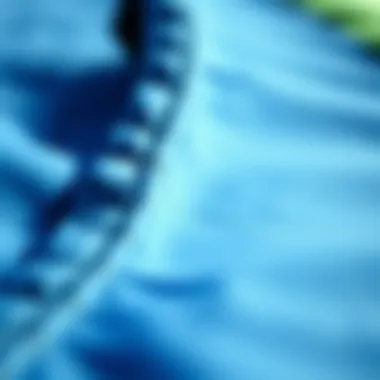
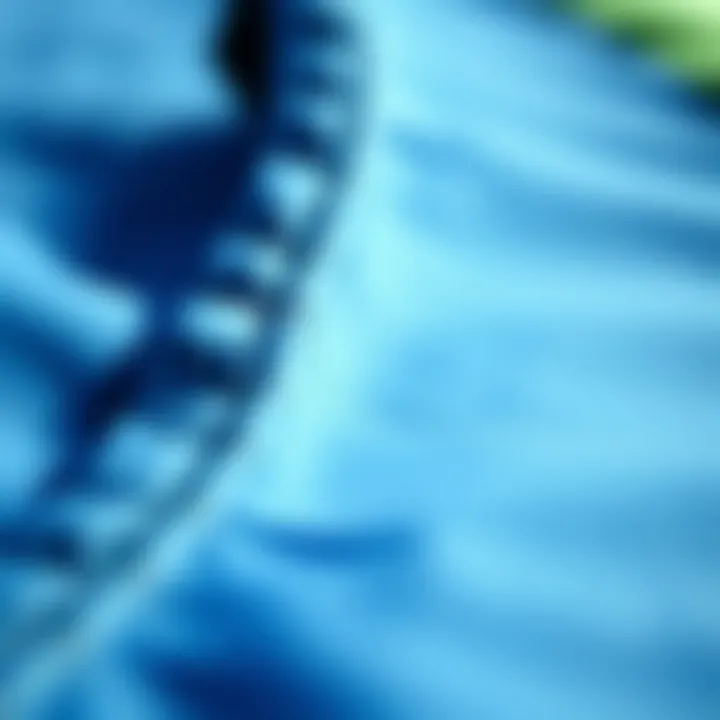
Harnesses
The harness is the link between the rider and the kite, suspending the rider and distributing the pull across the body. Customizing this fit is vital, as an ill-fitting harness could lead to discomfort or even injury. There are two main types: waist harnesses and seat harnesses. Waist harnesses allow for greater freedom of movement, while seat harnesses offer more support, especially for beginners. Understanding your personal comfort and how each style affects your performance will go a long way in enhancing the riding experience.
Control Bars
Control bars are the steering mechanism of the kite. They allow riders to manage the kite's position in the wind and are crucial for both control and safety. A good control bar comes with features like safety systems, adjustable lengths, and comfortable grips. Riders should familiarize themselves with how these bars work, as they are pivotal during any maneuver. The right control bar can enhance responsiveness, making it easier to handle different kite sizes and improve overall performance.
Wetsuits and Safety Gear
While they may not directly influence performance, wetsuits and safety gear are indispensable for kiteboarding safety and comfort. Wetsuits protect against cold water and provide a layer of buoyancy, while additional gear such as helmets, impact vests, and flotation devices can save lives in unexpected situations. It’s advisable for every kiteboarder to invest in quality safety gear because the water, while thrilling, can be unpredictable.
Equipping oneself with knowledge about these basic components not only streamlines the selection process but also contributes to a more enjoyable kiteboarding experience. Understanding what each part does and how it interacts with the rest of the equipment arms riders with the tools they need for informed purchasing decisions.
"Your setup is only as good as your understanding of each piece, you'll find your riding will exponentially improve with the right knowledge."
By grasping the key details of kites, boards, harnesses, controls, and safety gear, kiteboarders can navigate the gear landscape with confidence.
Factors Influencing Equipment Prices
Understanding the intricacies of the kiteboarding equipment market is fundamental for enthusiasts looking to invest wisely. The prices of gear can vary considerably, influenced by multiple determinants that reflect both quality and demand. To make educated purchasing decisions, one must consider the following elements that impact pricing.
Material Quality
Material quality stands as a cornerstone in the longevity and performance of kiteboarding gear. Equipment crafted with high-grade materials often commands a higher price due to enhanced durability and safety features. For instance,
- Kite Fabrics: Premium kites typically utilize ripstop nylon or polyester that withstands the harsh elements without fraying or tearing easily.
- Board Construction: Boards made with lightweight composites and marine-grade finishes not only feel better to ride but also last longer when exposed to water and varying weather conditions.
Investing in top-notch materials ensures that gear can withstand the frequent wear and tear associated with kiteboarding, consequently saving money in the long run on replacements.
Brand Reputation
Brand reputation plays a vital role in the kiteboarding industry, influencing both quality and price. Well-established brands like Cabrinha or North Kiteboarding, known for their innovation and reliable performance, often set higher prices reflective of consumer trust. Consumers might pay a premium for branded gear, believing it promises superior performance, effective support, and customer service. Moreover,
- Warranty and Support: Reputable brands usually offer better warranty packages, which adds value over time, comforting buyers regarding potential defects or issues.
- Community Trust: Brand community can significantly affect resale value; popular brands retain demand even in the second-hand market.
Thus, while venturing into brand territory, understanding its track record can shape your decision significantly.
Product Features and Innovations
Modern advances in kiteboarding technology influence pricing as manufacturers integrate innovative features aimed at enhancing performance and user experience. Here’s how:
- Safety Mechanisms: Gear that incorporates safety features, like quick-release mechanisms on control bars, naturally reaches a higher price point as they add peace of mind.
- User-Friendly Designs: Technology that simplifies setup and adjustments allows both new and seasoned riders to maximize their time on the water, often warranting a higher cost for added convenience.
The cutting-edge features laden with new gear may seem pricey upfront but often translate into significant performance boosts, making them worth the investment.
Market Demand
Market demand fluctuates with trends, recreational interest spikes, and even environmental conditions common in kiteboarding hotspots. These variations manifest in pricing dynamics. For example:
- Seasonal Peaks: During peak kiteboarding seasons or following high-profile competitions, prices tend to escalate as demand surges.
- Limited Editions: Specialty products or limited runs often see inflated prices due to scarcity and collector interest, making them attractive purchases for avid enthusiasts.
Ultimately, being aware of market trends can provide advantages when timing purchases for the best deals instead of potentially paying a premium during high demand periods.
The combined understanding of material quality, brand reputation, product innovation, and market demand equips kiteboarders with the knowledge needed to make smart buying choices, ensuring they invest wisely in their passion.
Cost Breakdown of Essential Gear
Understanding the breakdown of costs associated with kiteboarding gear is crucial for beginner and seasoned kiteboarders alike. Knowing how much to expect can help you strategically invest in equipment that suits your style and experience. A well-planned budget can also prevent unexpected financial strains, allowing you to enjoy the sport without financial stress. Moreover, equipment investments reflect in performance and safety, making it essential to grasp what you're paying for.
Beginner Kits
For those just dipping their toes into kiteboarding, a beginner kit is a more economical starting point. Typically, these kits include the essentials—a kite, a board, and a harness. On average, a decent beginner kit can range from $700 to $1,500, depending on brand and features.
When selecting a beginner kit, consider the following:
- Kite Size: Bigger kites catch more wind, but they require skill to control. A medium size is often perfect for learning.
- Board Type: A larger board offers stability, but it's crucial to learn how to maneuver it.
- Warranty and Support: Many brands offer warranties or customer support—something to look for.
This entry-level expenditure can set the foundation for exciting progression in the sport. For many newcomers, the thrill lies in mastering the basics without breaking the bank.
Intermediate Gear
If you’ve already got a good grip on the basics and are looking to level up, intermediate gear is the next logical step. This equipment ranges from $1,500 to $3,000, featuring improvements in material and design. Intermediate-level kits typically include enhanced kites and boards or even specialized harnesses that allow for better performance.
Points to consider:
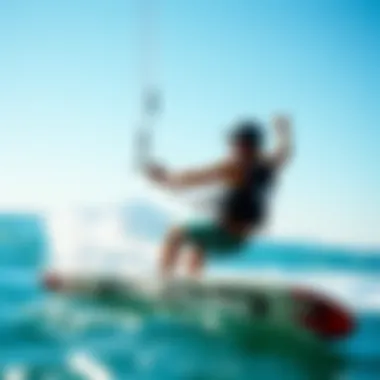
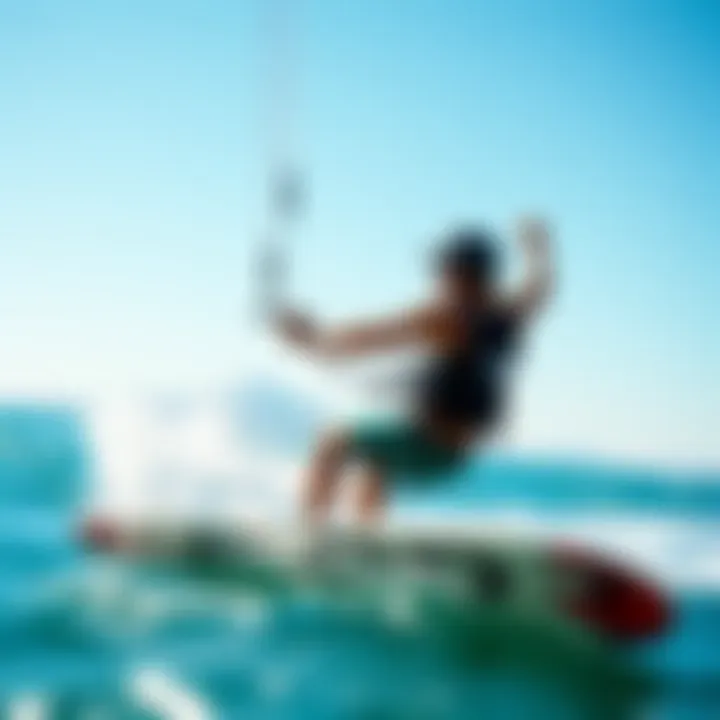
- Performance Enhancements: Look for kites designed for specific wind conditions or styles—freestyle or wave riding.
- Durability: Higher-quality materials will often mean better durability, crucial for those who kite regularly.
- Versatility: Some boards can adapt to multiple styles, which can be useful if you’re exploring what you enjoy most.
Investing in intermediate gear provides not just improved performance but also confidence on the water, enabling riders to push limits further.
Advanced Equipment
For seasoned riders, the advanced equipment landscape offers a tantalizing array of options. These products can run from $3,000 to upwards of $5,000, as they often boast the latest technology, superior materials, and refined designs. Advanced gear is all about enhancing your skills and maximizing your fun.
When looking at this level of equipment, pay attention to:
- Custom Specifications: Some brands allow customization, ensuring your gear fits your individual style and ability level perfectly.
- Lightweight Materials: Advanced materials can reduce drag and improve control, making your sessions smoother and more enjoyable.
- Latest Innovations: Stability, response time, and overall ride can greatly improve with the newest technology, which is important for competitive riders.
In summary, while investing in advanced equipment involves a significant financial commitment, the potential benefits—performance, safety, and overall enjoyment—can outweigh the costs. A smart investment here not only cultivates long-term skills but also enriches your kiteboarding experience.
"The gear you choose reflects your commitment to the sport and can elevate both your performance and enjoyment levels."
Ultimately, having a clear understanding of the costs associated with kiteboarding gear at different levels ensures you make informed and strategic purchases. For more insights on kiteboarding gear, you can check resources such as Wikipedia, Britannica, or community discussions on Reddit.
Thus, the cost breakdown serves as both a guide and a checklist as you navigate your kiteboarding journey.
Budgeting for Kiteboarding Purchases
When it comes to diving into the world of kiteboarding, budgeting is not just an afterthought—it's a fundamental part of the adventure. Understanding what you’re getting into financially can save you from a world of hurt down the line. Kiteboarding gear certainly isn’t pocket change, so knowing how to budget effectively helps you make savvy purchases while ensuring that you get the most bang for your buck.
Initial Investment Considerations
The initial cost of getting into kiteboarding can send some people running for the hills. Typically, a new kiteboarding setup, which includes a kite, board, harness, and control bar, can set you back anywhere from a few hundred to several thousand dollars. It's important to remember that with kiteboarding, you often get what you pay for. Opting for high-quality gear means it will last longer and perform better.
Factors to keep in mind when making that initial investment include:
- Skill Level: If you’re just starting out, you might not need the latest and greatest gear. Entry-level kits often provide adequate performance to help you learn the ropes without breaking the bank.
- Local Conditions: Will you be riding in light winds or choppy waters? Your gear choice should match the conditions you’ll face most frequently.
- Buy Just What You Need: It can be tempting to load up on all kinds of extra gear, but starting with essentials is often the best approach. You can always add more later.
Ultimately, consider visiting local shops or joining kiteboarding forums like those on Reddit to get insights on what's best for your needs. Spending time researching helps avoid impulse buys, which can lead to regrettable purchases.
Maintenance Costs
Once you've made your initial purchase, it’s crucial to factor in the ongoing maintenance costs associated with your kiteboarding gear. Like any sport, kiteboarding requires a level of care to keep everything functioning properly.
Regular maintenance involves:
- Inspecting Gear: After each session, take time to check your kite for damages, ensure your lines aren’t frayed, and that your harness remains in good shape.
- Washing: Saltwater and sand can wreak havoc on your equipment, so a good rinse after each use helps elongate the life of your gear.
- Repairs: Accidents happen. Learn basic repairs or consider local services for more extensive fixes to keep costs down. A small tear in your kite can create bigger issues if left unattended.
These maintenance considerations average between $50 to $200 annually, depending on your usage and local conditions. This is where it's important to budget annually for upkeep, ensuring that your gear stays in top-notch condition.
Replacement and Upgrade Cycles
As you become more experienced, you may find that your needs change. The gear that suited you well when starting out may not serve you as you improve your skills. Understanding when to replace or upgrade your equipment is key to managing ongoing costs effectively.
Here are some guidelines to consider:
- Lifespan of Gear: Kites generally have a lifespan of 2-3 years, while boards can last longer, often up to 5 years or more with proper care. Keeping this in mind can inform how you plan replacements.
- Consider Upgrades: If you find yourself consistently outgrowing your gear, consider budgeting for upgradable items like a board or harness tailored to advanced progression. Equipment that enhances performance can often be worth the investment.
- Timing for Purchases: Picking off-season for replacements can lead to significant savings, especially if you’re tracking sales and discount events.
Ultimately, drafting a budget for replacements allows for a smoother transition when you decide to invest in new equipment, and it minimizes the shock of sudden expenses.
In summary, effective budgeting for kiteboarding isn’t just about the initial outlay; it encompasses maintenance, replacements, and an eye toward what your future needs might be. Knowing the costs involved keeps the focus on enjoying the thrilling experience kiteboarding offers, without getting caught up in financial worries.
Comparative Pricing Analysis
Understanding comparative pricing analysis is a crucial aspect when navigating the financial terrain of kiteboarding equipment. It helps buyers dissect where their hard-earned money is going and ensures that they make informed purchases. This segment digs into the nuances of local versus online retail pricing, insights into the second-hand market, and how seasonal discounts can eventually lead to significant savings. Armed with this knowledge, kiteboarders, both new and seasoned, can better strategize their purchases.
Local vs. Online Retail Pricing
When considering where to buy equipment, the choice between local retailers and online shops often comes down to convenience versus personal touch. Local stores provide the immediate benefit of seeing gear first-hand, trying it on, and receiving personalized advice from staff who know their stuff. However, the price tags in brick-and-mortar shops can sometimes take a bite out of your wallet.
- Pros of Local Retail:
- Immediate access to the equipment.
- Ability to test sizes and features.
- Personalized customer service.
On the flip side, online retailers like Amazon or specialized kiteboarding websites may offer cheaper prices due to lower overhead costs. But be mindful of shipping fees and potential wait times.
- Pros of Online Retail:
- Generally lower prices.
- Wider selection of brands and models.
- Convenience of shopping from home.
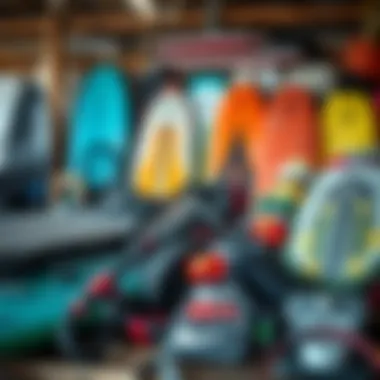
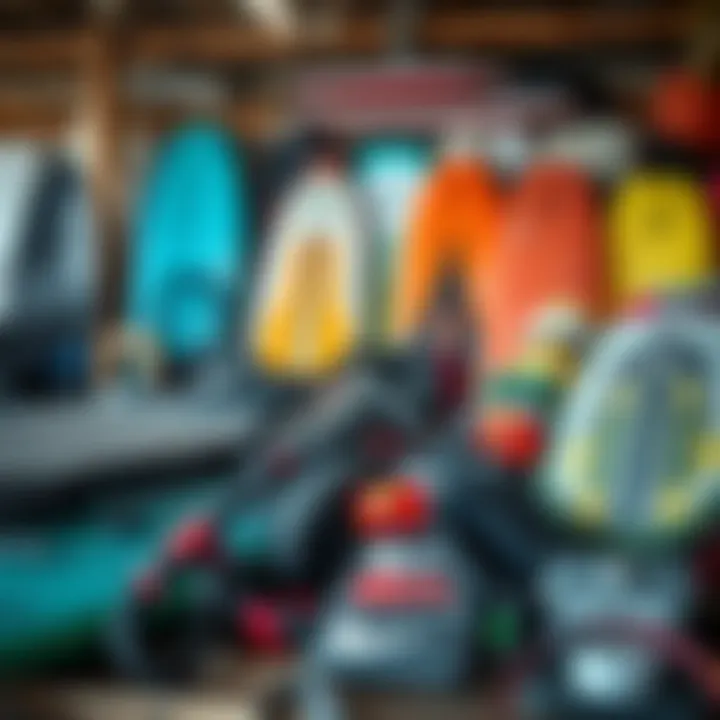
Finding the right balance between these two options often entails a bit of legwork. Some savvy shoppers opt to do research locally and then make the purchase online, leveraging the best of both worlds.
Second-Hand Market Insights
The second-hand kiteboarding market is a treasure trove waiting to be explored for those looking to save a few bucks. Many kiteboarders upgrade their gear regularly, meaning that perfectly good equipment can find its way into the hands of a new owner at a fraction of the price.
Places like Facebook Marketplace or specialized forums, such as reddit.com/r/kiteboarding, are ripe with opportunities, but buyers should tread carefully. Here are some key considerations when purchasing used gear:
- Inspect for damage, wear, and tear.
- Verify the condition of crucial components like kites and boards.
- Ask questions about the previous owner’s experience and use of the equipment.
While the savings can be significant in the second-hand market, it’s important to weigh the risks. Sometimes, paying a little more for a new piece might offer more peace of mind in terms of warranties and guarantees.
Seasonal Discounts and Sales
Timing can be everything when it comes to snagging the best deals on kiteboarding equipment.
Many retailers offer special sales events aligned with the seasons, meaning that smart shoppers keep their eyes open for discounts during off-peak times. For instance, purchasing gear at the end of summer or during holiday sales can yield prices that are markedly lower than regular retail.
Here are some tips for maximizing savings through seasonal sales:
- Sign up for newsletters from local stores and online retailers.
- Follow kiteboarding brands on social media for flash sales.
- Keep an eye out for annual sales events, such as Black Friday or clearance sales.
Staying informed about these sales can not only ease the financial burden but also allow kiteboarders to invest in higher-quality gear that they might have otherwise passed over.
"A penny saved is a penny earned, but a well-spent penny can lead to a great day on the water."
In closing, the comparative pricing analysis of kiteboarding equipment not only enables riders to understand where they can save but also helps them appreciate the value of their investments. Being strategic about purchases ensures that whether one opts for local shops, second-hand purchases, or sales events, confidence in decision-making aligns with financial wisdom.
Key Considerations Before Purchasing Equipment
Kiteboarding is not just a sport; it is a passion that requires a thoughtful approach when it comes to investing in equipment. Before diving into purchases, there are key considerations that can steer your decision-making process. This segment aims to guide you on how to evaluate your choices based on your skill level, local conditions, and future plans. Effectively navigating these aspects helps you avoid costly mistakes and ensures that your gear aligns with your specific needs.
Skill Level Assessment
One of the foremost factors to consider is your current skill level. Buying gear suited for advanced kiteboarders when you’re just starting can lead to challenges and discouragement. For instance, a beginner may benefit from a more stable kite that offers easy handling, while seasoned riders might prefer a more agile and responsive model.
- For beginners, look for:
- Intermediate riders should seek equipment that allows for advancement:
- Larger kites that are easier to pilot.
- Boards with more volume to ensure buoyancy.
- A balanced kite that offers decent performance.
- Lightweight boards for improved maneuverability.
Assessing your skills is more than just a self-evaluation; consider lessons or advice from instructors. They can provide insights that help you make informed purchases aligned with your development.
Local Conditions and Suitability
The conditions where you plan to kiteboard significantly impact your equipment choice. Factors such as wind speed, water type, and local regulations can dictate what gear will serve you best. Different environments demand different specifications.
- Considerations based on conditions:
- Wind: If local conditions tend to have high winds, smaller kites might be more suitable to manage the power effectively.
- Water: Are you riding on choppy waves or flat water? Choppy conditions might necessitate a more robust board design.
- Regulations: Some areas have specific rules regarding the size and type of kites allowed. Make sure your equipment is compliant to avoid issues.
This knowledge not only extends the life of your gear but enhances your overall experience on the water.
Future Needs and Expansion Plans
Lastly, think about your long-term involvement in kiteboarding. Planning for future needs is crucial when selecting gear. If you anticipate progressing quickly, it might be wise to invest in gear that will grow with you rather than equipment that you’ll outgrow in a few months.
- Key Points to contemplate:
- Will you explore different styles, such as freestyle or wave riding? Choose versatile equipment that accommodates various activities.
- Are you likely to upgrade soon? Investing in quality gear at the outset might prove more economical in the long run.
Ultimately, a forward-thinking approach can prevent repeated purchases and allow you to focus on honing your skills rather than constantly swapping out gear.
This careful consideration of your skill level, local conditions, and future aspirations can significantly improve your kiteboarding journey, ensuring that every purchase is one that fills your sails and not your whole wallet.
By taking these elements into account, you not only invest wisely but also enhance your journey in kiteboarding. As you prepare for purchases, remember, informed choices lead to better experiences.
Closure
As we draw this analysis to a close, it becomes clear how vital understanding the costs associated with kiteboarding equipment is for any enthusiast looking to embark on or continue their journey in the sport. It isn't just about the price tag; it’s about making informed decisions that affect both your wallet and your overall experience on the water. Having a firm grasp of the elements that influence pricing can guide you in selecting the right gear that aligns with your skill level, local conditions, and future aspirations.
The Importance of Informed Purchases
When purchasing kiteboarding equipment, knowledge is your best friend. An informed buyer tends to consider more than just the visible aspects of the gear. The quality of materials, brand reputation, and innovative product features play a crucial role in achieving the best value for your money. By understanding these factors, you can avoid pitfalls, such as buying something that seems like a steal but doesn't hold up after a few sessions. An investment in high-quality gear often leads to durability and performance satisfaction over time. This means fewer replacements and upgrades down the road, giving you peace of mind as you enjoy the sport without the distraction of faulty equipment.
Furthermore, armed with knowledge, you can compare prices across various platforms—both local shops and online sources—ensuring you’re not leaving money on the table. Knowledge also empowers you to spot deals and recognize when to jump on sales without second-guessing your choices.
Long-Term Investment in Kiteboarding Skills
Kiteboarding is not just a fleeting hobby; it’s an exhilarating blend of skill, adventure, and personal growth. The gear you choose doesn't just facilitate your current level but profoundly influences your ability to progress and refine your skills. Investing in appropriate equipment can lead to a marked improvement in your skills, as well-made, innovative gear allows for better performance and safety during your sessions.
Moreover, as you enhance your abilities, your equipment needs will evolve. Hence, selecting equipment that not only fits your current prowess but lends room for growth serves as a long-term strategy. This foresight can save you money in the long run, as you won't be stuck in a cycle of frequent upgrades that don't effectively meet your advancing requirements. Therefore, a well-planned investment today in quality gear holds the promise of a more enjoyable, thrilling journey on the water for years to come.
The right gear is not just about keeping up with trends; it’s about matching your ambitions and passions with your choices and investments.







